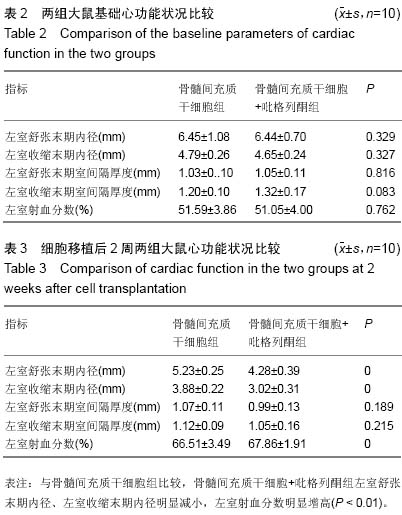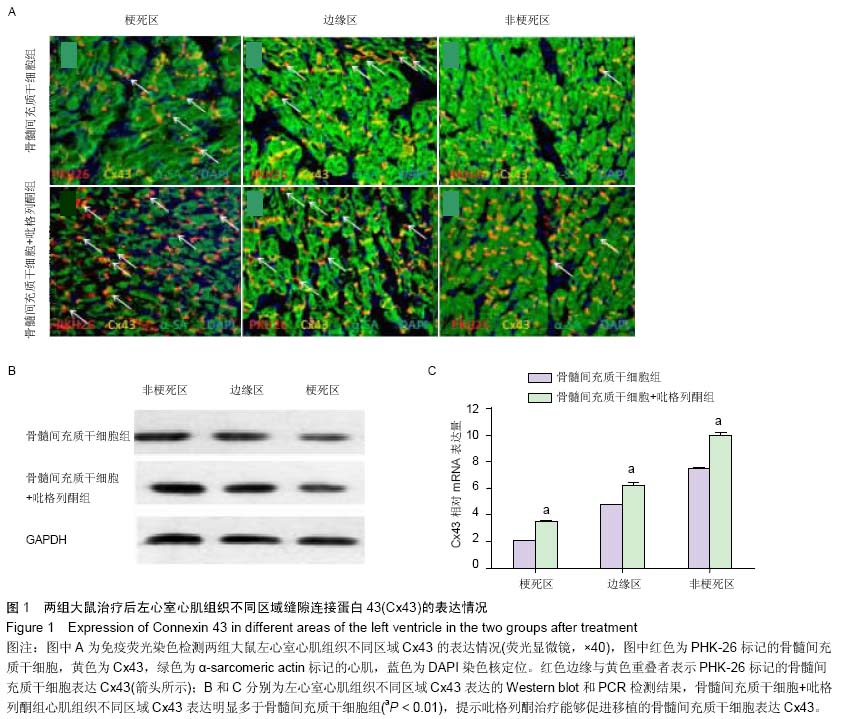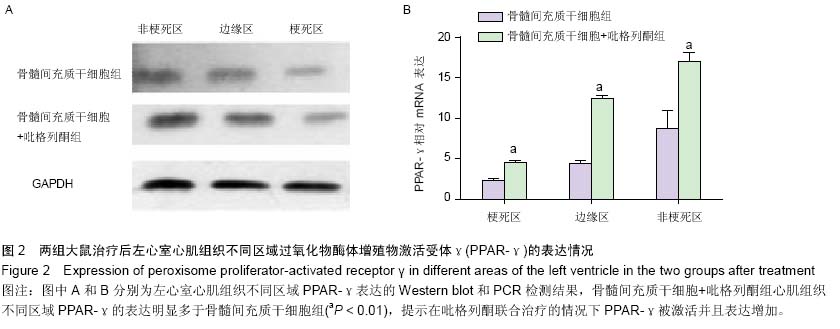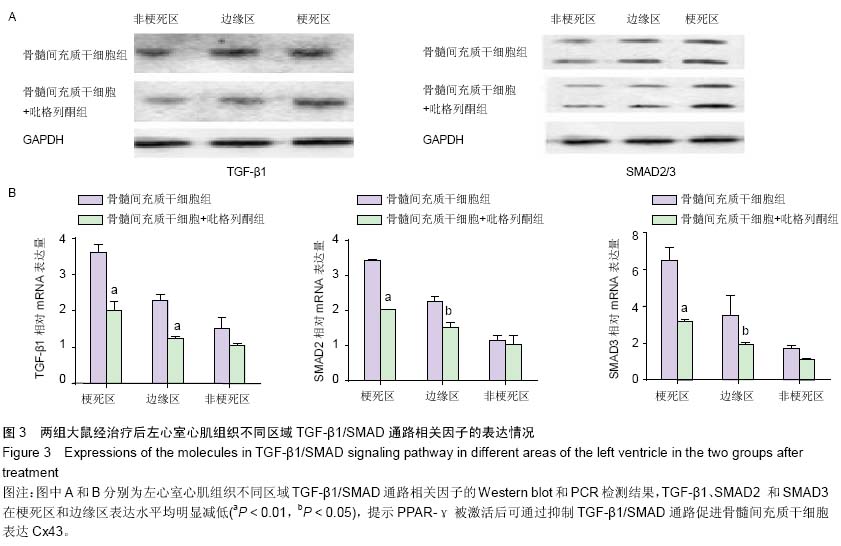| [1] Pavo N, Charwat S, Nyolczas N, et al. Cell therapy for human ischemic heart diseases: critical review and summary of the clinical experiences. J Mol Cell Cardiol. 2014;75:12-24.
[2] Wen Z, Zheng S, Zhou C, et al. Repair mechanisms of bone marrow mesenchymal stem cells in myocardial infarction. J Cell Mol Med. 2011;15(5):1032-1043.
[3] Wang T, Tang W, Sun S, et al. Intravenous infusion of bone marrow mesenchymal stem cells improves myocardial function in a rat model of myocardial ischemia. Crit Care Med. 2007;35(11):2587-2593.
[4] Wang T, Tang W, Sun S, et al. Mesenchymal stem cells improve outcomes of cardiopulmonary resuscitation in myocardial infarcted rats. J Mol Cell Cardiol. 2009;46(3): 378-384.
[5] Wang T, Tang W, Sun S, et al. Improved outcomes of cardiopulmonary resuscitation in rats with myocardial infarction treated with allogenic bone marrow mesenchymal stem cells. Crit Care Med. 2009;37(3):833-839.
[6] Xing Y, Hou J, Guo T, et al. microRNA-378 promotes mesenchymal stem cell survival and vascularization under hypoxic-ischemic conditions in vitro. Stem Cell Res Ther. 2014; 5(6):130.
[7] Veeraraghavan R, Poelzing S, Gourdie RG. Old cogs, new tricks: a scaffolding role for connexin43 and a junctional role for sodium channels. FEBS Lett. 2014;588(8):1244-1248.
[8] Severs NJ, Bruce AF, Dupont E, et al. Remodelling of gap junctions and connexin expression in diseased myocardium. Cardiovasc Res. 2008;80(1):9-19.
[9] Wang D, Shen W, Zhang F, et al. Connexin43 promotes survival of mesenchymal stem cells in ischaemic heart. Cell Biol Int. 2010;34(4):415-423.
[10] Taniguchi Ishikawa E, Gonzalez-Nieto D, Ghiaur G, et al. Connexin-43 prevents hematopoietic stem cell senescence through transfer of reactive oxygen species to bone marrow stromal cells. Proc Natl Acad Sci U S A. 2012;109(23):9071- 9076.
[11] Takada I, Makishima M. PPARγ ligands and their therapeutic applications: a patent review (2008 - 2014). Expert Opin Ther Pat. 2015;25(2):175-191.
[12] Shinmura D, Togashi I, Miyoshi S, et al. Pretreatment of human mesenchymal stem cells with pioglitazone improved efficiency of cardiomyogenic transdifferentiation and cardiac function. Stem Cells. 2011;29(2):357-366.
[13] Qi HP, Wang Y, Zhang QH, et al. Activation of peroxisome proliferator-activated receptor γ (PPARγ) through NF-κB/Brg1 and TGF-β1 pathways attenuates cardiac remodeling in pressure-overloaded rat hearts. Cell Physiol Biochem. 2015; 35(3):899-912.
[14] Jeon KI, Kulkarni A, Woeller CF, et al. Inhibitory effects of PPARγ ligands on TGF-β1-induced corneal myofibroblast transformation. Am J Pathol. 2014;184(5):1429-1445.
[15] Copland IB, Lord-Dufour S, Cuerquis J, et al. Improved autograft survival of mesenchymal stromal cells by plasminogen activator inhibitor 1 inhibition.Stem Cells. 2009;27(2):467-477.
[16] Lu F, Zhao X, Wu J, et al. MSCs transfected with hepatocyte growth factor or vascular endothelial growth factor improve cardiac function in the infarcted porcine heart by increasing angiogenesis and reducing fibrosis. Int J Cardiol. 2013; 167(6):2524-2532.
[17] Yu YS, Shen ZY, Ye WX, et al. AKT-modified autologous intracoronary mesenchymal stem cells prevent remodeling and repair in swine infarcted myocardium. Chin Med J (Engl). 2010;123(13):1702-1708.
[18] Usuda D, Kanda T. Peroxisome proliferator-activated receptors for hypertension. World J Cardiol. 2014;6(8): 744-754.
[19] Lecarpentier Y, Claes V, Hébert JL. PPARs, Cardiovascular Metabolism, and Function: Near- or Far-from-Equilibrium Pathways. PPAR Res. 2010;2010. pii: 783273.
[20] Nagashima A, Watanabe R, Ogawa M, et al. Different roles of PPAR-γ activity on physiological and pathological alteration after myocardial ischemia. J Cardiovasc Pharmacol. 2012; 60(2):158-164.
[21] Werner CM, Schirmer SH, Gensch C, et al. The dual PPARα/γ agonist aleglitazar increases the number and function of endothelial progenitor cells: implications for vascular function and atherogenesis. Br J Pharmacol. 2014;171(10):2685- 2703.
[22] Zhao Q, Ye X. Additive value of adult bone-marrow-derived cell transplantation to conventional revascularization in chronic ischemic heart disease: a systemic review and meta-analysis. Expert Opin Biol Ther. 2011;11(12):1569-1579.
[23] Wang CH, Ciliberti N, Li SH, et al. Rosiglitazone facilitates angiogenic progenitor cell differentiation toward endothelial lineage: a new paradigm in glitazone pleiotropy. Circulation. 2004;109(11):1392-1400.
[24] Zambrano S, Blanca AJ, Ruiz-Armenta MV, et al. L-carnitine attenuates the development of kidney fibrosis in hypertensive rats by upregulating PPAR-γ. Am J Hypertens. 2014;27(3): 460-470.
[25] Fan F, Li Y, Duan X, et al. Rosiglitazone attenuates activation of human Tenon's fibroblasts induced by transforming growth factor-β1. Graefes Arch Clin Exp Ophthalmol. 2012;250(8): 1213-1220.
[26] Kim E, Fishman GI. Designer gap junctions that prevent cardiac arrhythmias. Trends Cardiovasc Med. 2013;23(2): 33-38.
[27] Hesketh GG, Shah MH, Halperin VL, et al. Ultrastructure and regulation of lateralized connexin43 in the failing heart. Circ Res. 2010;106(6):1153-1163.
[28] Bacova B, Radosinska J, Knezl V, et al. Omega-3 fatty acids and atorvastatin suppress ventricular fibrillation inducibility in hypertriglyceridemic rat hearts: implication of intracellular coupling protein, connexin-43. J Physiol Pharmacol. 2010; 61(6):717-723.
[29] Neuhaus J, Heinrich M, Schwalenberg T, et al. TGF-beta1 inhibits Cx43 expression and formation of functional syncytia in cultured smooth muscle cells from human detrusor. Eur Urol. 2009;55(2):491-497.
[30] de Oliveira FL, Araújo-Jorge TC, de Souza EM, et al. Oral administration of GW788388, an inhibitor of transforming growth factor beta signaling, prevents heart fibrosis in Chagas disease. PLoS Negl Trop Dis. 2012;6(6):e1696.
[31] Hou J, Wang L, Yan P, et al. Angiotensin II downregulates connexin 43 via TGF-β1 mediated signaling pathways in a rat model of myocardial infarction. Exp Clin Cardiol. 2014; 20(8): 2905-2940. |




.jpg)